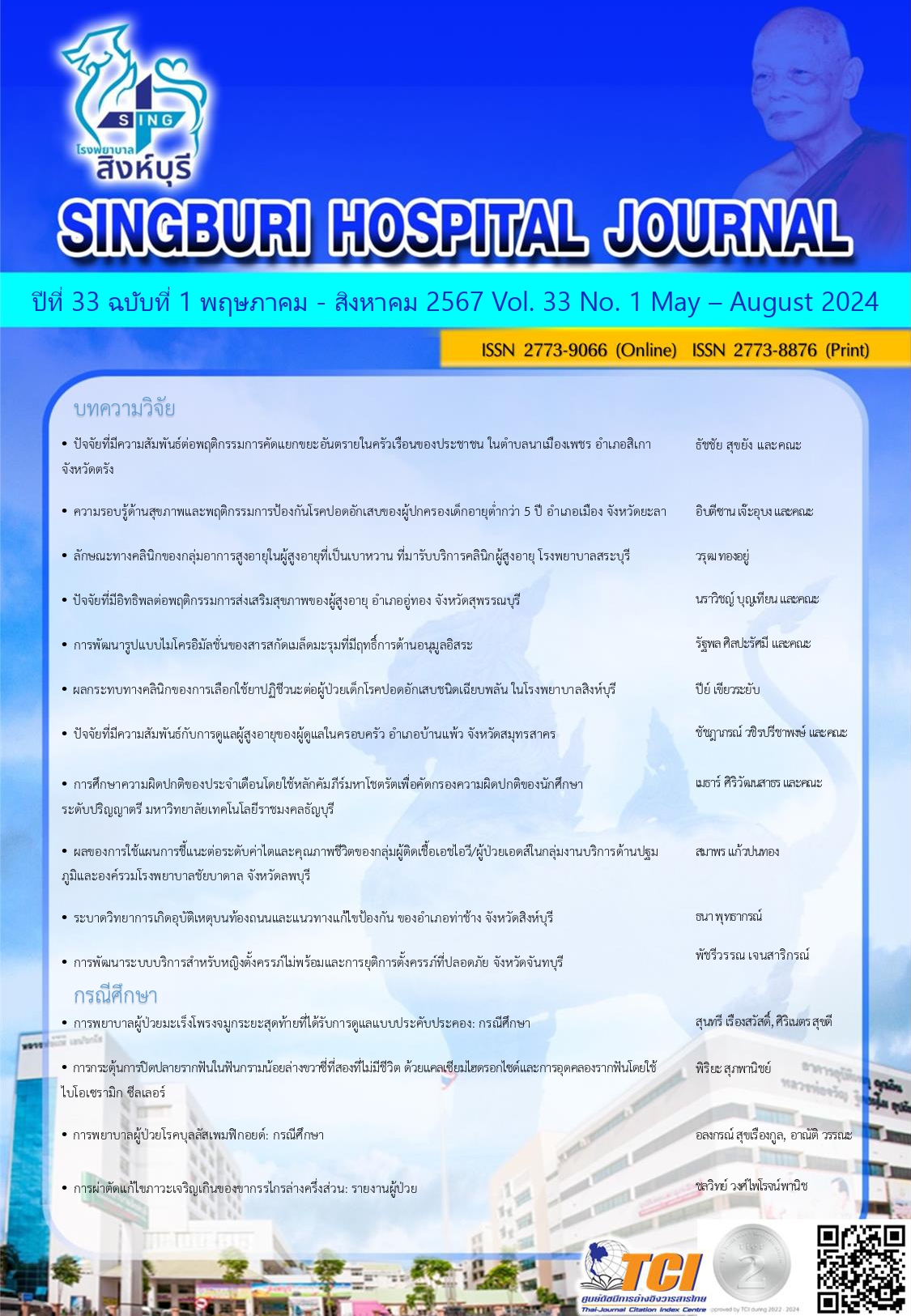การกระตุ้นการปิดปลายรากฟันในฟันกรามน้อยล่างขวาซี่ที่สองที่ไม่มีชีวิต ด้วยแคลเซียมไฮดรอกไซด์และการอุดคลองรากฟันโดยใช้ไบโอเซรามิก ซีลเลอร์
คำสำคัญ:
การปิดปลายคลองรากฟันด้วยแคลเซียมไฮดรอกไซด์, ฟันปลายรากเปิด, ไบโอเซรามิก ซีลเลอร์บทคัดย่อ
ฟันแท้ปลายรากฟันเปิดที่ไม่มีชีวิตมีสาเหตุประการหนึ่งมาจากการแตกหักของปุ่มนูนบนด้านบดเคี้ยวของตัวฟันทำให้ต้องได้รับการรักษาคลองรากฟัน ซึ่งมีความท้าทายในการรักษาคลองรากฟันให้มีคุณภาพ เนื่องจากฟันไม่มีจุดหยุดบริเวณปลายรากฟัน และมีผนังคลองรากฟันบาง จึงมีวิธีการรักษามากมายในการกระตุ้นให้เกิดการสร้างเนื้อเยื่อแข็งบริเวณปลายรากฟันด้วยวัสดุชนิดต่าง ๆ ก่อนที่จะทำการอุดคลองรากฟันด้วยวิธีการที่เหมาะสมต่อไป วิธีการรักษาหนึ่งที่ได้รับการยอมรับคือ การกระตุ้นการปิดปลายรากฟันด้วยแคลเซียมไฮดรอกไซด์ ซึ่งเป็นวิธีที่มีอัตราความสำเร็จสูงและประหยัดค่าใช้จ่าย กรณีศึกษาผู้ป่วยนี้จึงมีวัตถุประสงค์เพื่อนำเสนอการกระตุ้นการปิดปลายรากฟัน ด้วยแคลเซียมไฮดรอกไซด์ในฟันกรามน้อยล่างขวาซี่ที่สองที่ไม่มีชีวิตและการอุดคลองรากฟันโดยใช้ไบโอเซรามิก ซีลเลอร์
ผู้ป่วยหญิงไทยอายุ 12 ปี ฟันกรามน้อยล่างขวาซี่ที่สอง (ฟันซี่ 45) พบปุ่มนูนด้านบดเคี้ยวสึกและมีรูเปิดทางหนองไหลบริเวณปลายรากฟัน ภาพรังสีพบปลายรากฟันเปิดและมีรอยโรคบริเวณปลายรากฟัน ได้รับการวินิจฉัยว่า ฟันไม่มีชีวิตร่วมกับเนื้อเยื่อรอบปลายรากฟันอักเสบเรื้อรังแบบมีหนอง ให้การรักษาโดยการกระตุ้นปลายรากฟันให้ปิดด้วยแคลเซียมไฮดรอกไซด์ ระยะเวลา 4 เดือน ก่อนอุดปิดคลองรากฟันด้วยกัตทาเพอร์ชาและไบโอเซรามิกซีลเลอร์ ติดตามผลการรักษา 3 เดือนพบว่าฟันกรามน้อยล่างขวาซี่ที่สอง ไม่มีอาการใด ๆ เหงือกและอวัยวะปริทันต์อยูในเกณฑ์ปกติ ภาพรังสีรอบปลายรากฟันทึบรังสีขึ้นชัดเจน
การรักษาฟันแท้ปลายรากฟันเปิดที่ไม่มีชีวิตจำเป็นต้องได้รับการประเมินการเจริญของรากฟันที่ถูกต้อง เพื่อจะสามารถวางแผนการรักษาฟันได้อย่างเหมาะสม รวมถึงสามารถพยากรณ์โรคและอัตราความสำเร็จได้อย่างแม่นยำ ทั้งนี้เนื่องจากผลลัพธ์ในการรักษาที่ดีส่วนหนึ่งต้องได้รับความร่วมมือจากทั้งตัวผู้ป่วยและผู้ปกครอง นอกจากนี้ความรู้ ความเข้าใจ และทักษะในการรักษาของทันตแพทย์ก็เป็นอีกปัจจัยหนึ่งที่นำไปสู่ความสำเร็จของการรักษาได้
Downloads
เอกสารอ้างอิง
Levitan ME, Himel VT. Dens evaginatus: literature review, pathophysiology, and comprehensive treatment regimen. J Endod. 2006;32(1):1-9.
Chen JW, Huang GT, Bakland LK. Dens evaginatus: Current treatment options. J Am Dent Assoc. 2020;151(5):358-67.
Lin J, Zeng Q, Wei X, Zhao W, Cui M, Gu J, et al. Regenerative Endodontics Versus Apexification in Immature Permanent Teeth with Apical Periodontitis: A Prospective Randomized Controlled Study. J Endod. 2017;43(11):1821-7.
Kratunova E, Silva D. Pulp therapy for primary and immature permanent teeth: an overview. Gen Dent. 2018;66(6):30-8.
Shaik I, Dasari B, Kolichala R, Doos M, Qadri F, Arokiyasamy JL, et al. Comparison of the Success Rate of Mineral Trioxide Aggregate, Endosequence Bioceramic Root Repair Material, and Calcium Hydroxide for Apexification of Immature Permanent Teeth: Systematic Review and Meta-Analysis. J Pharm Bioallied Sci. 2021;13(Suppl 1):S43-s7.
Guide to clinical endodontics [Internet]. 2019 [cited December 17, 2023]. Available from: https://www.aae.org/specialty/clinical-resources/guide-clinical-endodontics/.
Jirathanyanatt T. New trends in endodontics therapy: Regenerative Endodontics. M Dent J. 2016;16(3):403-13.
Erdem AP, Sepet E. Mineral trioxide aggregate for obturation of maxillary central incisors with necrotic pulp and open apices. Dent Traumatol. 2008;24(5):e38-41.
Saulius Drukteinis JC. Bioceramic Materials in Clinical Endodontics. 1 ed. Switzerland: Springer Cham; 2021.
Mohammadi Z, Dummer PM. Properties and applications of calcium hydroxide in endodontics and dental traumatology. Int Endod J. 2011;44(8):697-730.
Plascencia H, Díaz M, Gascón G, Garduño S, Guerrero Bobadilla C, Márquez-De Alba S, et al. Management of permanent teeth with necrotic pulps and open apices according to the stage of root development. J Clin Exp Dent. 2017;9(11):e1329-39.
Sheehy EC, Roberts GJ. Use of calcium hydroxide for apical barrier formation and healing in non-vital immature permanent teeth: a review. Br Dent J. 1997;183(7):241-6.
Nosrat A, Seifi A, Asgary S. Regenerative endodontic treatment (revascularization) for necrotic immature permanent molars: a review and report of two cases with a new biomaterial. J Endod. 2011;37(4):562-7.
Metzger Z, Solomonov M, Mass E. Calcium hydroxide retention in wide root canals with flaring apices. Dent Traumatol. 2001;17(2):86-92.
ละอองทอง วัชราภัย. คลองรากฟัน:วิธีการรักษาและการแก้ปัญหา. พิมพ์ครั้งที่ 3. กรุงเทพฯ: ซันต้าการพิมพ์; 2562.ed. กรุงเทพฯ: ซันต้าการพิมพ์; 2562.
Tanomaru Filho M, Leonardo MR, Silva LA, Utrilla LS. Effect of different root canal sealers on periapical repair of teeth with chronic periradicular periodontitis. Int Endod J. 1998;31(2):85-9.
Khandelwal A, Janani K, Teja K, Jose J, Battineni G, Riccitiello F, et al. Periapical Healing following Root Canal Treatment Using Different Endodontic Sealers: A Systematic Review. Biomed Res Int. 2022;2022:3569281.
Whitworth J. Methods of filling root canals: principles and practices. Endodontic Topics. 2005;12(1):2-24.
Debelian G, Trope M. The use of premixed bioceramic materials in endodontics. Giornale Italiano di Endodonzia. 2016;30(2):70-80.
Lerdrungroj K, Banomyong D, Songtrakul K, Porkaew P, Nakornchai S. Current Management of Dens Evaginatus Teeth Based on Pulpal Diagnosis. J Endod. 2023;49(10):1230-7.
Wei X, Yang M, Yue L, Huang D, Zhou X, Wang X, et al. Expert consensus on regenerative endodontic procedures. Int J Oral Sci. 2022;14(1):55.
Tarcin B, Gumru B, Iriboz E, Turkaydin DE, Ovecoglu HS. Radiologic Assessment of Periapical Health: Comparison of 3 Different Index Systems. J Endod. 2015;41(11):1834-8.
Ong TK, Lim GS, Singh M, Fial AV. Quantitative Assessment of Root Development after Regenerative Endodontic Therapy: A Systematic Review and Meta-Analysis. J Endod. 2020;46(12):1856-66.e2.
Tong HJ, Rajan S, Bhujel N, Kang J, Duggal M, Nazzal H. Regenerative Endodontic Therapy in the Management of Nonvital Immature Permanent Teeth: A Systematic Review Outcome Evaluation and Meta-analysis. J Endod. 2017;43(9):1453-64.
Ballesio I, Marchetti E, Mummolo S, Marzo G. Radiographic appearance of apical closure in apexification: follow-up after 7-13 years. Eur J Paediatr Dent. 2006;7(1):29-34.
Guerrero F, Mendoza A, Ribas D, Aspiazu K. Apexification: A systematic review. J Conserv Dent. 2018;21(5):462-5.
Kim YJ, Chandler NP. Determination of working length for teeth with wide or immature apices: a review. Int Endod J. 2013;46(6):483-91.
Rosenberg DB. The paper point technique. Part 1. Dent Today. 2003;22(2):80-6.
Gawthaman M, Vinodh S, Mathian VM, Vijayaraghavan R, Karunakaran R. Apexification with calcium hydroxide and mineral trioxide aggregate: Report of two cases. J Pharm Bioallied Sci. 2013;5(Suppl 2):S131-4.
Minamisako M, Kinoshita J-I, Grando L, Jafarzadeh H. Apexification of a dens evaginated premolar with open apex. Cumhuriyet Dental Journal. 2015;18.
Chen CM, Lee KT, Chuang FH, Hong YY, Chen HC, Hsu KR, et al. Facial cellulitis arising from dens evaginatus: a case report. Kaohsiung J Med Sci. 2005;21(7):333-6.
CHO SY. Dental abscess in a tooth with intact dens evaginatus. International Journal of Paediatric Dentistry. 2006;16(2):135-8.
Ng YL, Mann V, Rahbaran S, Lewsey J, Gulabivala K. Outcome of primary root canal treatment: systematic review of the literature -- Part 2. Influence of clinical factors. Int Endod J. 2008;41(1):6-31.
Drukteinis S, Peciuliene V, Shemesh H, Tusas P, Bendinskaite R. Porosity Distribution in Apically Perforated Curved Root Canals Filled with Two Different Calcium Silicate Based Materials and Techniques: A Micro-Computed Tomography Study. Materials (Basel). 2019;12(11).
Chybowski EA, Glickman GN, Patel Y, Fleury A, Solomon E, He J. Clinical Outcome of Non-Surgical Root Canal Treatment Using a Single-cone Technique with Endosequence Bioceramic Sealer: A Retrospective Analysis. J Endod. 2018;44(6):941-5.
Palma PJ, Marques JA, Antunes M, Falacho RI, Sequeira D, Roseiro L, et al. Effect of restorative timing on shear bond strength of composite resin/calcium silicate-based cements adhesive interfaces. Clin Oral Investig. 2021;25(5):3131-9.
Palma PJ, Marques JA, Falacho RI, Vinagre A, Santos JM, Ramos JC. Does Delayed Restoration Improve Shear Bond Strength of Different Restorative Protocols to Calcium Silicate-Based Cements? Materials (Basel). 2018;11(11).
Vilas-Boas DA, Grazziotin-Soares R, Ardenghi DM, Bauer J, de Souza PO, de Miranda Candeiro GT, et al. Effect of different endodontic sealers and time of cementation on push-out bond strength of fiber posts. Clin Oral Investig. 2018;22(3):1403-9.
Lee JY, Shin SJ, Park JW. Influence of Phosphoric Acid Etching on Bond Strength for Calcium Silicate-Based Sealers. J Endod. 2023;49(5):514-20.
Upanisakorn M. Treatment of Endodontic-Periodontic Lesion: a Case Study of patient with Primary Endodontic Lesion. Singburi Hospital Journal. 2023;31(3):172-185
ดาวน์โหลด
เผยแพร่แล้ว
รูปแบบการอ้างอิง
ฉบับ
ประเภทบทความ
สัญญาอนุญาต
ลิขสิทธิ์ (c) 2024 โรงพยาบาลสิงห์บุรี

อนุญาตภายใต้เงื่อนไข Creative Commons Attribution-NonCommercial-NoDerivatives 4.0 International License.
บทความที่ได้รับการตีพิมพ์เป็นลิขสิทธิ์ของโรงพยาบาลสิงห์บุรี
ข้อความที่ปรากฏในบทความแต่ละเรื่องในวารสารวิชาการเล่มนี้เป็นความคิดเห็นส่วนตัวของผู้เขียนแต่ละท่านไม่เกี่ยวข้องกับโรงพยาบาลสิงห์บุรี และบุคคลากรท่านอื่นๆในโรงพยาบาลฯ แต่อย่างใด ความรับผิดชอบองค์ประกอบทั้งหมดของบทความแต่ละเรื่องเป็นของผู้เขียนแต่ละท่าน หากมีความผิดพลาดใดๆ ผู้เขียนแต่ละท่านจะรับผิดชอบบทความของตนเองแต่ผู้เดียว







